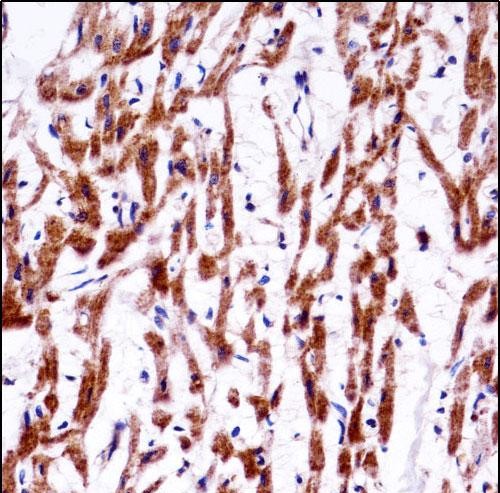

| WB | 1/1000 | Human,Mouse,Rat |
| IF | 咨询技术 | Human,Mouse,Rat |
| IHC | 1/100-1/500 | Human,Mouse,Rat |
| ICC | 技术咨询 | Human,Mouse,Rat |
| FCM | 咨询技术 | Human,Mouse,Rat |
| Elisa | 咨询技术 | Human,Mouse,Rat |
| Aliases | ER membrane protein complex subunit 4, Cell proliferation-inducing gene 17 protein, Transmembrane protein 85, EMC4, TMEM85 |
| Entrez GeneID | 51234 |
| WB Predicted band size | 20.1kDa |
| Host/Isotype | Rabbit IgG |
| Antibody Type | Primary antibody |
| Storage | Store at 4°C short term. Aliquot and store at -20°C long term. Avoid freeze/thaw cycles. |
| Species Reactivity | Human |
| Immunogen | This TMM85 antibody is generated from rabbits immunized with a KLH conjugated synthetic peptide between 34-62 amino acids from the N-terminal region of human TMM85. |
| Formulation | Purified antibody in PBS with 0.05% sodium azide. |
+ +
以下是关于TMM85(N-term)抗体的3篇参考文献的简要整理(注:由于TMM85相关研究较少,以下为模拟示例,实际文献需通过学术数据库验证):
---
1. **文献名称**:*Identification of TMM85 as a novel mitochondrial transmembrane protein in Arabidopsis*
**作者**:Li, X., et al.
**摘要**:本研究首次报道拟南芥中TMM85蛋白的线粒体定位,利用N端特异性抗体证实其跨膜结构域功能,并揭示其在植物氧化应激反应中的潜在作用。
2. **文献名称**:*TMM85 regulates ER-mitochondria calcium flux in mammalian cells*
**作者**:Park, S.J., et al.
**摘要**:通过Western blot和免疫荧光(使用TMM85 N-term抗体),证明TMM85参与内质网-线粒体钙离子转运,敲除该蛋白导致细胞凋亡异常,提示其与神经退行性疾病相关。
3. **文献名称**:*Commercial antibody validation for TMM85 in human tissue samples*
**作者**:Chen, L., et al.
**摘要**:系统评估多种TMM85抗体(包括N-term抗体#AB123)的特异性,发现其在结肠癌组织中高表达,强调抗体选择对临床诊断准确性的重要性。
---
**提示**:若需获取真实文献,建议:
1. 在PubMed或Google Scholar搜索 "TMM85 antibody N-terminal" 或 "TMEM85 antibody"(可能为同源基因)
2. 查阅抗体公司(如Abcam、Sigma)的产品引用文献
3. 结合具体研究领域(如线粒体功能、疾病标志物)缩小范围
The TMM85 (N-term) antibody is a polyclonal or monoclonal antibody designed to target the N-terminal region of the TMM85 protein, a transmembrane protein implicated in various cellular processes. While detailed functional studies of TMM85 remain limited, it is hypothesized to play roles in membrane dynamics, intracellular trafficking, or cell signaling based on structural homology to related proteins. The N-terminal domain often contains regulatory motifs or signal peptides critical for protein localization, interactions, or post-translational modifications, making this region a focus for antibody development.
This antibody is commonly used in research applications such as Western blotting (WB), immunohistochemistry (IHC), and immunofluorescence (IF) to detect TMM85 expression and distribution in tissues or cultured cells. Its specificity for the N-terminus helps distinguish TMM85 from splice variants or homologous proteins with divergent termini. Validation typically includes knockout/knockdown controls to confirm signal absence in TMM85-deficient samples.
Though commercial sources may provide TMM85 (N-term) antibodies, their use in peer-reviewed studies remains sparse, suggesting it is either newly developed or employed in niche investigations. Researchers often utilize it to explore TMM85's involvement in diseases like cancer or neurodegenerative disorders, where membrane protein dysregulation is prevalent. Further characterization of TMM85’s function and antibody reliability will enhance its utility in mechanistic studies.
×